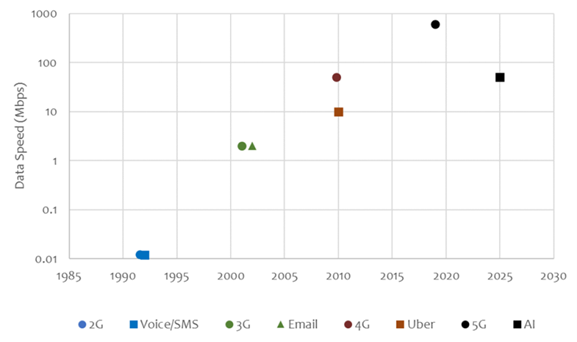Apple will be introducing a new service along with iPhone 16. Tim Cook recently said that he sees “generative AI as a key opportunity across [Apple] products.” We interpret this to mean that Siri will be extended to support interesting use cases.
People will search for items in photos. They’ll analyze video content. Eventually, the AI assistant will be navigating and auto-filling online forms for the user. Can I get Siri to do my taxes for me? Oh, H&R Block is working on that app.
In 2007-2008, the iPhone broke the AT&T network as the growth of mobile data consumption was much faster than expected due to the large touchscreen. There’s a strong chance that this could happen again, as the 5G network is currently configured for heavy downlink traffic and light uplink traffic. Heavy AI-assistant applications could drive unexpected levels of uplink load.

I’m a bit of a technology historian. Looking at the mobile technology generations, it was fascinating to see that the applications for 2G, 3G and 4G were known when the networks were deployed. (Some people have forgotten that Uber launched in 2010 on PCs, and only migrated to 4G LTE in 2011. Netflix started with DVDs and migrated to LTE/Wi-Fi over time.)
The 5G cycle has been different. While 5G has brought new capacity to the network and has enabled FWA business cases, no new applications were identified for the first five years that really use the features of 5G.
In fact, I have often said that all previous “Gs” had enabled wired applications to “go wireless.” When the internet “went wireless” in 2010-2011, we were able to do everything on 4G LTE that we had been doing on the PC. It’s a lot easier to monetize a new app when people are already paying for it on a different platform.
Gen-AI is moving faster than any technology in the world, ever. It’s now becoming established in search engines and many enterprises are using it in wired networks. So, it’s natural for Gen-AI to migrate to your phone. Some AI engines can run on your phone. Editing a photo is one example.
But if you scan the subway with your camera to find the right train platform, you will be uploading a video to Apple’s mapping database and receiving instructions via Gen-AI. This is extremely uplink heavy.
We already have navigation applications and retail shopping applications that help users to virtually try on sunglasses, clothing or even tattoos via Gen-AI video. This kind of functionality could be absorbed into AI assistants as well. Think of it as integrating the camera into real-time activities in the real world. Very uplink heavy.
Mobile Experts has recently reported on the impact of these applications on the 5G network. Latency will be an issue, as the computing architecture will be distributed between handsets and the cloud and eventually the edge. The operators will need to make some changes. Some will be easy. Others will be hard. The operators will most definitely need more uplink capacity. For me, it’s the light of spring at the end of the 5G winter.
يمكن الاطلاع على المقال الأصلي على:
